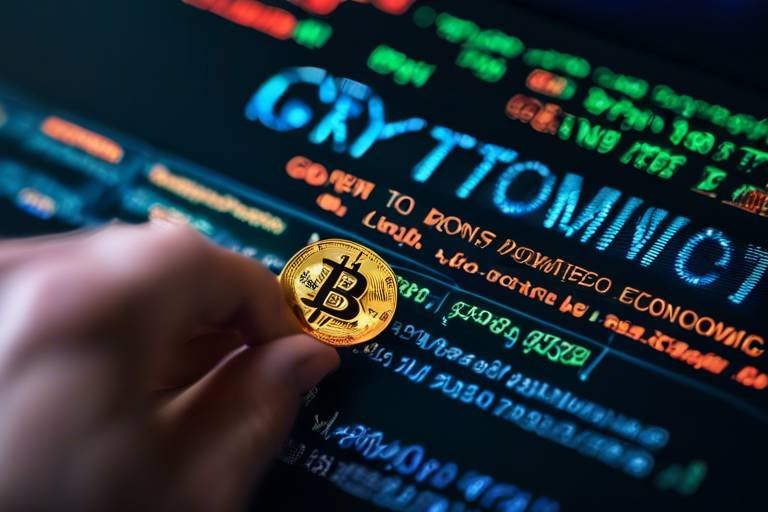Analyzing the Growth of Layer 2 Solutions and Their Impact
In the rapidly evolving world of blockchain technology, Layer 2 solutions have emerged as a beacon of hope for overcoming the inherent limitations of traditional blockchain networks. As we dive into this fascinating topic, it’s essential to understand not just what Layer 2 solutions are, but also the profound impact they have on the overall ecosystem. Imagine trying to navigate a bustling city during rush hour; the roads are congested, and every turn feels like a dead end. This is akin to the challenges faced by Layer 1 blockchains, where transaction speeds and costs can skyrocket during peak usage times. Layer 2 solutions act as the express lanes in this scenario, allowing for smoother, faster, and more cost-effective transactions.
The evolution of these technologies is nothing short of revolutionary. They are designed to enhance scalability without compromising the security and decentralization that are the hallmarks of blockchain. By building on top of existing Layer 1 networks, Layer 2 solutions can process transactions off-chain or in a more efficient manner, drastically reducing the load on the base layer. This not only increases transaction throughput but also enhances the user experience, making blockchain technology more accessible to the masses. In this article, we will explore the architecture of Layer 2 solutions, their significance in addressing scalability issues, and the transformative effects they have across various industries.
As we embark on this exploration, it’s important to recognize the growing interest and investment in Layer 2 technologies. Major players in the crypto space are increasingly adopting these solutions to mitigate the challenges posed by congestion and high fees. For instance, Ethereum, one of the most widely used blockchains, has seen a surge in Layer 2 implementations such as Optimistic Rollups and zk-Rollups, which promise to enhance transaction speed and reduce costs significantly. This shift not only signifies a growing acknowledgment of the limitations of Layer 1 but also highlights the potential for Layer 2 to redefine how we interact with blockchain technology.
In conclusion, the growth of Layer 2 solutions is not just a trend; it represents a fundamental shift in the blockchain landscape. By addressing the critical issues of scalability and cost efficiency, these solutions are paving the way for broader adoption and innovation. As we continue to analyze their impact, it becomes clear that Layer 2 solutions are not merely enhancements but integral components of the future of blockchain technology.
- What are Layer 2 solutions? Layer 2 solutions are protocols built on top of existing blockchains to improve scalability and efficiency.
- How do Layer 2 solutions improve transaction speeds? They allow for off-chain transactions and bundle multiple transactions, significantly speeding up the process.
- What industries are benefiting from Layer 2 solutions? Industries such as finance, gaming, and supply chain are seeing transformative effects from these technologies.
- Will Layer 2 solutions replace Layer 1 blockchains? No, they are designed to complement Layer 1 networks, enhancing their capabilities rather than replacing them.

Understanding Layer 2 Solutions
Layer 2 solutions are like the superchargers of the blockchain world, designed to boost the capabilities of existing Layer 1 networks. Imagine driving a car that can only go so fast; now, picture adding a turbocharger that allows it to zoom past the speed limit. That's essentially what Layer 2 solutions do for blockchains. They operate on top of the main blockchain (Layer 1) and are built to enhance scalability, reduce transaction costs, and improve overall efficiency. By taking some of the load off the main network, these solutions allow for a smoother and more efficient experience for users.
At their core, Layer 2 solutions tackle the inherent limitations of Layer 1 networks, which often struggle with issues like high fees and slow transaction speeds during peak times. Think of Layer 1 as the main highway, where traffic can get congested during rush hour. Layer 2 acts like a series of express lanes, allowing vehicles (transactions) to bypass the gridlock and reach their destination faster. This is accomplished through various architectures, such as state channels and rollups, which we'll explore in detail later. By utilizing these technologies, Layer 2 solutions can process transactions off the main chain, thereby freeing up space and resources.
It's also important to understand that not all Layer 2 solutions are created equal. They can be categorized into different types based on their architecture and use cases. For example, some solutions focus on off-chain transactions, while others bundle transactions together to enhance efficiency. Each type has its unique advantages and challenges, which can affect how they are adopted across different sectors. The versatility of Layer 2 solutions makes them a hot topic in the blockchain community, as they hold the key to unlocking the full potential of decentralized applications (dApps) and other blockchain innovations.
As we navigate through this exciting landscape, it's crucial to recognize the role that Layer 2 solutions play in shaping the future of blockchain technology. They are not merely a temporary fix to existing problems; they represent a foundational shift in how we think about scalability and efficiency in decentralized systems. By addressing the limitations of Layer 1 networks, Layer 2 solutions pave the way for broader adoption of blockchain technology across various industries.
In summary, Layer 2 solutions are essential for the evolution of blockchain technology. They enhance scalability, reduce costs, and improve user experience, making blockchain more accessible and efficient. As we delve deeper into the specifics of these solutions, we will uncover how they are revolutionizing the crypto ecosystem and what the future holds for their development.

The Importance of Scalability
When we talk about blockchain technology, one word that often comes up is scalability. But why is scalability so crucial? Imagine a busy highway during rush hour; the more cars that try to merge onto the road, the more congested it becomes. This is similar to what happens with Layer 1 networks when too many transactions occur simultaneously. Scalability is the ability of a blockchain to handle a growing amount of work or its potential to accommodate growth. Without it, user experience can suffer, leading to frustration and abandonment of the technology altogether.
Layer 1 networks, like Bitcoin and Ethereum, are foundational to the blockchain ecosystem. However, they face significant challenges as they scale. The limitations of these networks include slow transaction speeds and high fees during peak times. For instance, during a popular event or a market surge, the number of transactions can skyrocket, causing delays and soaring costs. This is where Layer 2 solutions come into play, effectively acting as a safety valve for the blockchain.
Layer 2 solutions tackle these challenges head-on by enhancing transaction throughput and reducing congestion. They operate on top of existing Layer 1 blockchains, allowing for a more efficient handling of transactions. Here are some of the ways Layer 2 solutions improve scalability:
- Increased Transaction Throughput: By offloading transactions from the main chain, Layer 2 solutions can process many more transactions per second.
- Lower Congestion: With fewer transactions clogging the main blockchain, users experience faster confirmation times.
- Enhanced User Experience: A smoother, faster interaction with the blockchain encourages more users to participate in the ecosystem.
To put this into perspective, let's consider a hypothetical scenario. Imagine a popular online store during a holiday sale. If the store's website can only handle a limited number of visitors at once, many customers will experience slow load times, and some may not even be able to complete their purchases. However, if the store implements a scalable solution, it can accommodate a surge of shoppers, ensuring everyone has a seamless experience. This analogy mirrors the way Layer 2 solutions enable blockchain networks to handle increased demand without sacrificing performance.
In summary, scalability is not just a technical requirement; it is a fundamental aspect of blockchain's future success. As more individuals and businesses adopt blockchain technology, the need for efficient, scalable solutions becomes increasingly evident. Layer 2 solutions are paving the way for a more robust and accessible blockchain ecosystem, ensuring that everyone can enjoy the benefits without the headaches of congestion and high costs.

Transaction Speed Improvements
When it comes to the world of blockchain, one of the most pressing issues is transaction speed. Imagine trying to send a message to a friend, but the network is so congested that it takes minutes, if not hours, for it to reach them. Frustrating, right? This is essentially what happens on Layer 1 networks, where transaction speeds can be sluggish due to high demand and limited throughput. Enter Layer 2 solutions, the knights in shining armor that promise to revolutionize the way we think about speed in the blockchain realm.
Layer 2 solutions tackle the issue of transaction speed head-on by employing various innovative technologies. These solutions allow transactions to occur off the main blockchain (Layer 1), which significantly reduces the load on the network. By moving transactions off-chain, Layer 2 can achieve lightning-fast speeds, enabling users to complete transactions in mere seconds. For instance, state channels and rollups are two prominent technologies that have emerged to enhance transaction speeds.
Let's dive deeper into these technologies:
- State Channels: These are like private tunnels for transactions. They allow users to conduct multiple transactions off-chain and then settle the final result on the main blockchain. This means that only the initial and final states are recorded on the Layer 1 network, drastically reducing the number of transactions that need to be processed. As a result, users can enjoy instant transactions with minimal fees.
- Rollups: Think of rollups as a way to bundle a bunch of transactions together into a single package. This technique not only minimizes the data that needs to be processed on the main chain but also enhances efficiency. By aggregating transactions, rollups can significantly increase the throughput of the network, allowing for thousands of transactions to be processed simultaneously.
To illustrate the impact of these technologies, consider the following table that compares transaction speeds across different blockchain solutions:
| Blockchain Solution | Transaction Speed (TPS) | Notes |
|---|---|---|
| Bitcoin (Layer 1) | 7 TPS | Limited scalability; slower during peak times |
| Ethereum (Layer 1) | 30 TPS | Often congested; high gas fees |
| State Channels (Layer 2) | Thousands of TPS | Instant transactions; low fees |
| Rollups (Layer 2) | Up to 2000 TPS | Efficient bundling of transactions |
As you can see, the difference in transaction speeds is staggering. With Layer 2 solutions, users no longer have to wait around for their transactions to be confirmed. Instead, they can enjoy a seamless experience where transactions occur almost instantaneously. This shift not only enhances user satisfaction but also encourages broader adoption of blockchain technology.
In conclusion, the improvements in transaction speed brought about by Layer 2 solutions are nothing short of revolutionary. By enabling faster, more efficient transactions, these technologies are paving the way for a more scalable and user-friendly blockchain ecosystem. As we continue to explore the potential of Layer 2, it's clear that the future of blockchain is not just about security or decentralization; it's also about speed and accessibility.
- What are Layer 2 solutions? Layer 2 solutions are protocols built on top of existing blockchains to enhance scalability and efficiency.
- How do state channels improve transaction speed? State channels allow for off-chain transactions, enabling multiple interactions without congesting the main blockchain.
- What are rollups? Rollups bundle multiple transactions into a single one, optimizing efficiency and increasing transaction throughput.
- Why is transaction speed important? Faster transaction speeds improve user experience, reduce congestion, and encourage broader adoption of blockchain technology.

State Channels
State channels are an innovative solution designed to enhance the efficiency of blockchain transactions by enabling off-chain interactions. Imagine a busy highway during rush hour; traffic is slow, and everyone is stuck in their cars. Now, picture a dedicated express lane just for a few select vehicles — that’s what state channels do for blockchain transactions. They allow users to conduct multiple transactions off the main chain, significantly reducing congestion and improving speed.
So, how do state channels actually work? They operate by creating a private channel between two parties, which allows them to transact freely without immediately recording each transaction on the blockchain. This is akin to having a private conversation where only the final outcome is shared with the world. Initially, both parties lock a certain amount of cryptocurrency in a multi-signature wallet, which acts as collateral. Throughout their interaction, they can exchange messages and update their balances without involving the entire network.
Once the parties have completed their transactions, they can close the channel, and only the final state is recorded on the blockchain. This method not only speeds up the transaction process but also significantly reduces the fees associated with each individual transaction. The benefits are clear:
- Speed: Transactions are almost instantaneous, as they don't require confirmation from the entire network.
- Cost: Since fewer transactions are recorded on the blockchain, users save on gas fees.
- Privacy: Transactions within the channel are not publicly visible, ensuring confidentiality.
To illustrate the effectiveness of state channels, consider a gaming platform where players can make numerous in-game purchases. Instead of processing each transaction on the main blockchain, which could lead to delays and high fees, the platform can utilize state channels to allow players to transact freely. Once they finish playing, the final balance is settled on the blockchain, making the entire experience smoother and more enjoyable.
However, it's essential to note that state channels are not a one-size-fits-all solution. They work best in scenarios where participants need to conduct multiple transactions with each other. For instance, they may not be ideal for one-off transactions or interactions with a larger group of users. Nonetheless, as blockchain technology continues to evolve, state channels represent a promising avenue for enhancing transaction speeds and user experiences.
In summary, state channels are a powerful tool in the blockchain toolkit, enabling faster, cheaper, and more private transactions. They offer a glimpse into the future of blockchain scalability, paving the way for more efficient applications across various industries.
- What are state channels? State channels are private channels that allow two parties to conduct multiple transactions off-chain before recording the final state on the blockchain.
- How do state channels improve transaction speed? By allowing transactions to occur off-chain, state channels eliminate the need for each transaction to be confirmed by the entire network, resulting in faster processing times.
- Are state channels secure? Yes, state channels are secure as they use multi-signature wallets to ensure that both parties must agree before any funds are moved.

Rollups
Rollups are an innovative and powerful solution in the realm of Layer 2 technologies, designed to enhance the scalability of blockchain networks. By bundling multiple transactions into a single batch, rollups significantly reduce the amount of data that needs to be processed on the main blockchain, or Layer 1. This not only helps in alleviating congestion but also optimizes the overall efficiency of the network. Imagine trying to fit a large number of people into a small elevator—if you can group them together and send them up in one go, you save time and space. That’s essentially what rollups do for blockchain transactions.
There are two primary types of rollups: Optimistic Rollups and ZK-Rollups. Each has its unique approach to ensuring security and efficiency:
| Type of Rollup | How It Works | Key Benefits |
|---|---|---|
| Optimistic Rollups | Assume transactions are valid by default and only check them if challenged. | Lower computational costs and faster transaction speeds. |
| ZK-Rollups | Use zero-knowledge proofs to validate transactions off-chain before submitting them. | Enhanced security and privacy, with quicker finality. |
Rollups not only enhance transaction throughput but also maintain the security of the underlying Layer 1 blockchain. By processing transactions off-chain and then submitting a single proof back to the main chain, rollups ensure that users can enjoy faster transactions without compromising on trust or decentralization. This is akin to having a trusted friend handle your errands—while they do the legwork, you can focus on more important tasks, knowing that everything will be taken care of efficiently.
Furthermore, rollups have become a vital part of various blockchain ecosystems, especially in decentralized finance (DeFi) and non-fungible tokens (NFTs). As these sectors continue to grow, the demand for efficient transaction processing will only increase, making rollups an essential component of future blockchain solutions. By leveraging the power of rollups, developers can create applications that offer seamless user experiences, reduced fees, and faster transaction times.
In conclusion, rollups represent a significant leap forward in blockchain technology, offering a practical solution to the scalability challenges faced by Layer 1 networks. As the crypto landscape evolves, the adoption of rollups will likely play a crucial role in shaping the future of decentralized applications and services.
- What are rollups in blockchain? Rollups are Layer 2 solutions that bundle multiple transactions into a single batch to improve scalability and reduce congestion on the main blockchain.
- What are the two main types of rollups? The two primary types are Optimistic Rollups and ZK-Rollups, each with distinct mechanisms for ensuring security and efficiency.
- How do rollups improve transaction speed? By processing transactions off-chain and submitting a single proof back to the main chain, rollups significantly reduce the data load on the network.
- Can rollups be used in DeFi? Yes, rollups are increasingly being utilized in decentralized finance applications to enhance transaction speeds and reduce costs.

Cost Efficiency
When we talk about Layer 2 solutions, one of the most compelling aspects that come to mind is their remarkable ability to enhance . In a world where transaction fees can skyrocket, especially during peak times, Layer 2 technologies offer a breath of fresh air. They tackle the often exorbitant costs associated with blockchain transactions, making it feasible for everyday users to engage with the crypto ecosystem without breaking the bank.
Imagine trying to buy a coffee with your crypto wallet, only to find out that the transaction fee is higher than the price of the coffee itself! Frustrating, right? That's where Layer 2 solutions step in. By processing transactions off the main blockchain, they significantly reduce the fees associated with each transaction. This is particularly crucial for microtransactions, which are becoming increasingly popular in various sectors.
To give you a clearer picture, let’s break down the cost efficiency of Layer 2 solutions compared to traditional Layer 1 networks. The table below illustrates the differences in transaction costs:
| Transaction Type | Layer 1 Cost | Layer 2 Cost |
|---|---|---|
| Standard Transaction | $3.00 | $0.10 |
| Microtransaction | $0.50 | $0.01 |
| Smart Contract Execution | $5.00 | $0.50 |
As you can see from the table, the savings are substantial. This cost efficiency not only makes transactions more accessible but also encourages wider adoption of blockchain technology. Users are more likely to engage with services that don’t impose hefty fees, leading to increased activity and innovation within the ecosystem.
Moreover, the reduced costs enable developers and businesses to experiment and innovate without the fear of incurring massive expenses. They can build applications that leverage these cost-effective solutions, fostering a new wave of decentralized applications (dApps) that were previously stifled by high fees. This creates a ripple effect, enriching the entire blockchain landscape.
In essence, Layer 2 solutions are doing more than just slashing costs; they are paving the way for a more inclusive and vibrant blockchain environment. With lower transaction fees, users can engage more freely, and businesses can explore new opportunities without the burden of excessive costs. It's a win-win situation that holds tremendous promise for the future of digital transactions.
- What are Layer 2 solutions? Layer 2 solutions are protocols built on top of existing blockchains to enhance scalability and efficiency.
- How do Layer 2 solutions reduce transaction costs? They process transactions off the main blockchain, significantly lowering fees associated with each transaction.
- What are some examples of Layer 2 solutions? Examples include state channels and rollups, both of which optimize transaction processing.
- Why is cost efficiency important in blockchain? Lower transaction costs make blockchain technology more accessible to users, encouraging wider adoption and innovation.

Real-World Applications
Layer 2 solutions are not just theoretical constructs; they are actively being implemented across various industries, revolutionizing how we interact with blockchain technology. Imagine a world where transactions are instantaneous, costs are negligible, and user experiences are seamless. Sounds like a dream, right? Well, thanks to Layer 2 solutions, this dream is becoming a reality. These technologies are paving the way for innovative applications in sectors like finance, gaming, and supply chain management.
In the finance sector, for instance, Layer 2 solutions are enabling Decentralized Finance (DeFi) platforms to operate more efficiently. By leveraging these technologies, DeFi projects can process a higher volume of transactions without the congestion typically associated with Layer 1 networks. This not only enhances user experience but also opens the door for more complex financial products and services that were previously impractical due to scalability issues.
Furthermore, the gaming industry is witnessing a significant transformation as well. With the rise of non-fungible tokens (NFTs) and play-to-earn models, gamers are demanding faster and cheaper transactions. Layer 2 solutions address these needs by providing the infrastructure necessary for quick in-game transactions and NFT trading. Imagine being able to buy, sell, and trade digital assets in real-time without worrying about high gas fees or long wait times. This level of efficiency is reshaping the gaming landscape.
To illustrate the impact of Layer 2 solutions, consider the following table that highlights some notable real-world applications:
| Industry | Application | Layer 2 Solution | Benefits |
|---|---|---|---|
| Finance | Decentralized Exchanges (DEXs) | Optimistic Rollups | Faster trades, lower fees |
| Gaming | In-game Transactions | State Channels | Instant transactions, enhanced user experience |
| Supply Chain | Asset Tracking | Plasma | Improved transparency, reduced costs |
In supply chain management, Layer 2 solutions are improving transparency and efficiency. By allowing for real-time tracking of assets, businesses can ensure that products are authentic and delivered on time. This not only enhances trust among consumers but also reduces operational costs associated with logistics and inventory management.
In summary, the real-world applications of Layer 2 solutions are vast and varied. They are not just enhancing existing systems but are also creating entirely new paradigms in how we think about finance, gaming, and supply chains. With these advancements, we are moving closer to a more efficient and user-friendly blockchain ecosystem.
- What are Layer 2 solutions? Layer 2 solutions are protocols built on top of existing blockchains to improve scalability and efficiency.
- How do Layer 2 solutions enhance transaction speeds? They allow for off-chain transactions or bundle multiple transactions together, significantly reducing processing time.
- What industries are benefiting from Layer 2 solutions? Industries like finance, gaming, and supply chain management are seeing transformative effects from these technologies.
- Are Layer 2 solutions cost-effective? Yes, they typically lower transaction fees, making blockchain technology more accessible to users.

DeFi Innovations
Decentralized Finance, commonly known as DeFi, is undergoing a remarkable transformation, largely fueled by the rise of Layer 2 solutions. These innovations are not just improving the speed and efficiency of transactions; they are fundamentally reshaping the way financial services operate in the blockchain ecosystem. Imagine a world where traditional banking processes are replaced by seamless, borderless transactions that are accessible to anyone with an internet connection. That’s the promise of DeFi, and Layer 2 solutions are the key to unlocking this potential.
One of the most significant impacts of Layer 2 solutions on DeFi is their ability to drastically reduce transaction costs. High fees on Layer 1 networks have often been a barrier for users, particularly for those engaging in smaller transactions. With Layer 2, fees can be reduced to mere cents, making it feasible for a broader audience to participate in DeFi activities such as lending, borrowing, and trading. This democratization of financial services is akin to opening the floodgates for a previously excluded population, allowing them to access tools that were once reserved for the wealthy.
Moreover, Layer 2 solutions enhance liquidity within DeFi platforms. By enabling faster and cheaper transactions, they encourage more users to engage in trading and liquidity provision. This increased activity leads to tighter spreads and better prices for users, creating a more vibrant and competitive market. For example, platforms utilizing Optimistic Rollups or ZK-Rollups can process thousands of transactions per second, which is a game-changer for traders and liquidity providers alike.
In addition to improving efficiency and reducing costs, Layer 2 solutions are also paving the way for innovative financial products. We are witnessing the birth of new protocols that leverage these technologies to offer unique services. Here are a few examples of how Layer 2 is driving DeFi innovation:
- Instant Loans: With Layer 2's speed, users can access loans almost instantaneously, allowing for dynamic trading strategies and arbitrage opportunities.
- Yield Farming: Layer 2 solutions facilitate complex yield farming strategies that were previously too costly due to high transaction fees.
- Cross-Chain DeFi: Interoperability between different Layer 2 solutions is emerging, allowing users to leverage assets across multiple chains seamlessly.
Furthermore, the integration of Layer 2 solutions with existing DeFi protocols is enhancing user experience. Imagine being able to swap tokens, provide liquidity, or stake assets without the frustrating delays and high costs that have plagued Layer 1 platforms. This improved user experience is crucial for attracting new users to the DeFi space, as it lowers the barrier to entry and encourages participation.
As we look to the future, the synergy between DeFi and Layer 2 solutions is likely to deepen. More projects are recognizing the benefits of scalability and cost efficiency, leading to a surge in Layer 2 adoption. This trend not only enhances the functionality of DeFi platforms but also fosters innovation, creating a rich ecosystem of financial services that are accessible to everyone.
In conclusion, the innovations brought about by Layer 2 solutions are nothing short of revolutionary for the DeFi landscape. They are transforming how we think about finance, making it more inclusive, efficient, and user-friendly. As these technologies continue to evolve, we can expect to see even more groundbreaking developments that will further disrupt traditional financial systems.
- What are Layer 2 solutions? Layer 2 solutions are protocols built on top of existing blockchains that enhance scalability and efficiency by processing transactions off the main chain.
- How do Layer 2 solutions improve DeFi? They reduce transaction costs and increase speed, making DeFi services more accessible and efficient for users.
- What are some examples of Layer 2 technologies? Examples include State Channels, Optimistic Rollups, and ZK-Rollups, each with unique mechanisms to enhance blockchain performance.
- Is DeFi safe with Layer 2 solutions? While Layer 2 solutions offer many benefits, users should conduct thorough research and understand the risks associated with any DeFi platform.

Gaming and NFTs
The gaming industry is undergoing a remarkable transformation, thanks to the integration of Layer 2 solutions. These innovations are not just enhancing gameplay; they are revolutionizing the entire experience for players and developers alike. Imagine a world where your in-game assets are not just pixels on a screen, but real digital collectibles that you can own, trade, and sell. This is the promise of NFTs (Non-Fungible Tokens) combined with Layer 2 technology, creating a seamless bridge between gaming and the blockchain.
One of the most significant advantages of Layer 2 solutions in gaming is the drastic reduction in transaction costs and speeds. Traditional blockchain networks often struggle with congestion, leading to slow transaction times and high fees. However, with Layer 2, gamers can execute transactions almost instantly and at a fraction of the cost. This means that microtransactions, which are crucial in gaming, can be processed effortlessly, allowing players to purchase skins, upgrades, or even entire games without worrying about exorbitant fees.
Moreover, the incorporation of NFTs into gaming allows players to have true ownership of their digital assets. Unlike traditional games where items are locked within the game ecosystem, NFTs enable players to buy, sell, or trade their items on various marketplaces. This opens up a whole new economy within games, where players can earn real money through their skills and investments. For instance, a rare in-game sword or a unique character skin can be sold for a substantial amount, creating an incentive for players to engage more deeply with the game.
Consider the popular game Axie Infinity, which has captured the attention of gamers and investors alike. This game utilizes Layer 2 solutions to facilitate smooth gameplay and transactions. Players can breed, battle, and trade their Axies (digital pets) as NFTs, creating a vibrant marketplace. The success of Axie Infinity showcases how Layer 2 can enhance user experience while simultaneously driving economic opportunities within the gaming ecosystem.
Furthermore, Layer 2 solutions are not just beneficial for players; they also provide developers with the tools to create richer, more engaging experiences. With lower fees and faster transactions, developers can experiment with new game mechanics, such as play-to-earn models, where players can earn rewards for their time and effort. This shift towards user-centric models is reshaping the gaming landscape, making it more inclusive and rewarding for everyone involved.
As we look ahead, the future of gaming and NFTs powered by Layer 2 solutions seems incredibly promising. Developers are increasingly recognizing the potential of blockchain technology to create immersive worlds where ownership and value are paramount. With the ongoing advancements in Layer 2 technology, we can expect to see even more innovative games that push the boundaries of creativity and engagement.
In conclusion, the synergy between gaming, NFTs, and Layer 2 solutions is paving the way for a new era in digital entertainment. Players are no longer just consumers; they are active participants in a thriving ecosystem where their contributions and investments are recognized and rewarded. As this trend continues to grow, the gaming industry will undoubtedly evolve, offering experiences that are not only entertaining but also financially rewarding.
- What are Layer 2 solutions? Layer 2 solutions are protocols designed to enhance the scalability and efficiency of existing blockchain networks by processing transactions off the main chain.
- How do NFTs work in gaming? NFTs represent unique digital assets that players can own, trade, and sell, providing true ownership of in-game items.
- What advantages do Layer 2 solutions provide for gamers? They offer faster transaction speeds, lower fees, and the ability to engage in microtransactions seamlessly.
- Can players earn money through gaming with NFTs? Yes, players can earn real money by trading or selling their NFTs, creating a new economy within the gaming space.

Future Trends in Layer 2 Development
As the blockchain landscape evolves, the future of Layer 2 solutions looks incredibly promising. With the increasing demand for faster, cheaper, and more efficient transactions, developers are constantly innovating to meet these needs. One of the most exciting trends is the integration of artificial intelligence (AI) and machine learning into Layer 2 protocols. Imagine a world where smart contracts can learn from user behavior, optimizing transaction routes and costs in real-time. This could revolutionize how we think about blockchain interactions.
Moreover, the rise of cross-chain compatibility is another significant trend. As various blockchains continue to proliferate, the ability for Layer 2 solutions to interact seamlessly across different networks will be crucial. This interoperability will not only enhance user experience but also foster a more cohesive ecosystem where assets can flow freely between platforms. Picture a digital marketplace where you can effortlessly swap assets from Ethereum to Solana without the usual hassles—this is the future that Layer 2 solutions are paving the way for.
Furthermore, sustainability is becoming a critical focus in the development of Layer 2 solutions. As environmental concerns grow, developers are prioritizing energy-efficient protocols that minimize the carbon footprint of blockchain transactions. This shift towards greener technologies is not just a trend; it's a necessity. The adoption of eco-friendly Layer 2 solutions could be the key to attracting more users and businesses to the blockchain space, making it more appealing to the environmentally-conscious audience.
In addition to these trends, we can expect to see enhanced security measures being integrated into Layer 2 solutions. As the crypto space matures, so do the threats it faces. Developers are exploring more robust security protocols and methodologies to protect users and their assets. For example, implementing advanced cryptographic techniques could ensure that off-chain transactions remain secure and tamper-proof, thereby bolstering user trust in these systems.
Finally, the growing interest in decentralized autonomous organizations (DAOs) is likely to influence Layer 2 development significantly. As DAOs gain traction, Layer 2 solutions will need to adapt to facilitate governance models that are efficient, transparent, and user-friendly. This evolution could lead to novel ways for communities to engage with blockchain technology, where every member has a say in how things operate, all while enjoying the benefits of enhanced scalability and reduced costs.
- What are Layer 2 solutions? Layer 2 solutions are protocols built on top of existing blockchains to improve scalability and transaction efficiency.
- How do Layer 2 solutions enhance transaction speed? They utilize mechanisms like state channels and rollups to process transactions off-chain or bundle them, significantly increasing throughput.
- What industries are adopting Layer 2 solutions? Industries such as finance, gaming, and supply chain are leveraging Layer 2 technologies for their scalability and cost-effectiveness.
- What future trends should we expect in Layer 2 development? Trends include AI integration, cross-chain compatibility, sustainability, enhanced security, and the influence of DAOs.
Frequently Asked Questions
- What are Layer 2 solutions?
Layer 2 solutions are protocols built on top of existing blockchains, designed to improve scalability and efficiency. They help tackle the limitations of Layer 1 networks by enabling faster transactions and reducing congestion, making blockchain technology more user-friendly.
- Why is scalability important in blockchain?
Scalability is crucial for the widespread adoption of blockchain technology. Without it, networks can become congested, leading to slower transaction times and higher costs. Layer 2 solutions address these challenges by increasing transaction throughput and ensuring a smoother user experience.
- How do state channels work?
State channels allow for off-chain transactions, which means that multiple transactions can occur outside the main blockchain, significantly speeding up interactions. Once the transactions are completed, only the final state is recorded on the blockchain, reducing the load and enhancing efficiency.
- What are rollups and how do they contribute to scalability?
Rollups are a Layer 2 solution that bundles multiple transactions into a single one before submitting it to the blockchain. This approach optimizes efficiency by reducing the amount of data that needs to be processed on-chain, allowing for faster transactions and lower costs.
- How do Layer 2 solutions reduce transaction costs?
By processing transactions off-chain or in a more efficient manner, Layer 2 solutions significantly lower the fees associated with transactions. This makes blockchain technology more accessible, especially for users who may find high transaction fees prohibitive.
- What are some real-world applications of Layer 2 solutions?
Layer 2 solutions are being utilized across various industries, including finance, gaming, and supply chain management. For instance, in Decentralized Finance (DeFi), they are enabling faster and cheaper transactions, while in gaming, they enhance user experiences by allowing seamless transactions for digital collectibles and in-game assets.
- How are Layer 2 solutions impacting the gaming industry?
Layer 2 solutions are revolutionizing the gaming industry by providing faster transaction speeds and lower costs, which are essential for real-time interactions in games. This technology also facilitates smoother transactions for NFTs, allowing gamers to buy, sell, and trade digital assets effortlessly.
- What future trends can we expect in Layer 2 development?
As blockchain technology continues to evolve, we can anticipate further innovations in Layer 2 solutions. These may include enhanced interoperability between different blockchains, improved security measures, and the development of new use cases that leverage the benefits of Layer 2 for various applications.



















